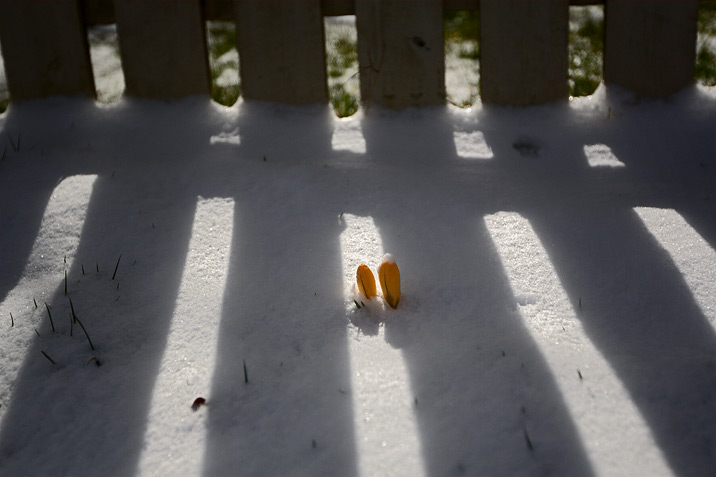
Myself and Justin had a great gig at the Sunset Room this past weekend, complete with folks being turned away at the door since we were at capacity. We did a combined tag set, 3 tracks each at a time, back and forth, back and forth. Our sounds mixed together better than ever before. My Macbook was what we were playing off of and it performed well once we got the settings right for the external audio card. It looks like I might have another show coming up in May.
The time change happened in the middle of our set, which meant our 12:30 AM – 4:00 AM set was actually only 2.5 hours. One thing I love about the time change is the longer hours of light in the evening, which means summer is well on its way! But wait a moment..
It snowed on Saturday and it snowed this morning. This is actually a post about the weather. I know, I am ashamed and it is boring. But it’s also part of life and what we walk through in the morning on the way to work. Folks out east, if you were thinking about paying more for housing to live on the west coast where there is no snow, soak it up! Or shovel it up as it were.
AFK @ Lucid
Lucid presents:
AFK (Pacific Front Recordings, Proton Music)
Other artists to be confirmed.
$20 at the door. Venue: Sunset Room
tags and categories
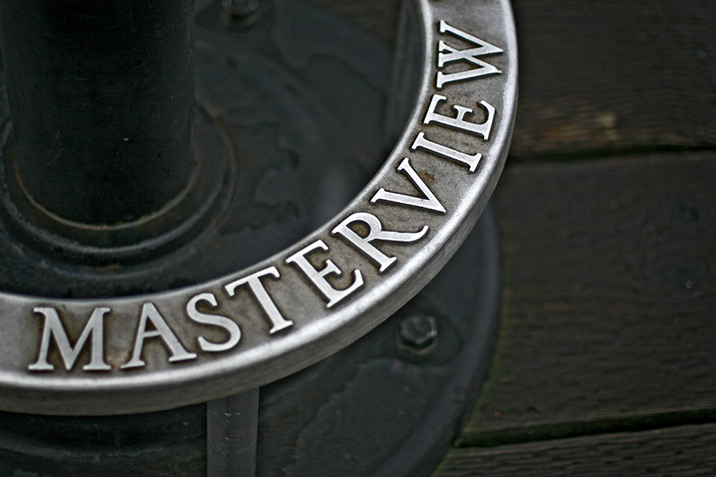
What is the difference between categories and tags, when would you need to use them, and what for? Would you ever need to use both at once? Within the context of blogging and, more broadly, the web, I’ve found myself explaining how to use tags and categories a few times in the last year. For this reason, I think it is a good idea to take a moment and document which principles I use to guide the creation of both and how to use them in a couple example scenarios.
First lets define categories and tags. Categories are defined as a division within a system of classification. Tags are keywords that are assigned to specific items, such as blog posts. We can already deduce two things from these simple definitions: categories require a system of classification for content, so you must have some context for your application of the term; tags require content on which they are based. In other words, content fits into categories, and tags fit the content. One is top down, the other is bottom up.
Lets use an example that could use both tags and categories at once for different purposes. If you are looking at MetroCascade‘s feed aggregator, you’ll see that have a system set up which pools new information brought in from sites that have RSS feeds for the Victoria area. Simply put, this is a hot spot for new information that is geographically relevant to the 250 area code.
Three questions which I would ask are:
- Who supplies this content?
- How will it be sought?
- What is the information about?
Categories and tags define and eventually answer those questions.
For MetroCascade I would see it most optimally set up this way:
Categories: News (Authoritarian – very high traffic – for seekers of current events in the area) , Blogs (Personal, lower traffic – for community and interest)
Tags: Dependent on content provided. Tags should always be content-maker defined as the writers will always understand the key words best through intent.
Tags will cross over between categories, so a tag search for “inner harbour” would show blog posts about the inner harbour as well as news. The distinction about categorizing the feeds into News and Blogs is most important for the kind of aggregation options that will be given to end users. If a user wanted to be a part of the Victoria blogosphere, but did not want to be pummeled by the local news stories, they could simply view the blogs category. Subjects would change, tags would go all over the place (as they might with news, if news organizations actually took the time to tag – some do), but at the end of the day you’d have a useful distinction of information through categories which catered to the nature of the source and the intended audience rather than the subject matter itself. Subject trends will emerge through things like tag-clouds. This allows for subject matter to flow freely, yet remain quickly accessible through the tag link drill-down.
Another quick, more tangible, example. Imagine you ran a library. You will have two master categories: fiction and non-fiction. Subjects, or tags, like “sports, dragons, politics, mathematics” may branch into both or only exist in one category. You could have a sports book on how to coach tennis, or a sports book on the story of a tennis star who summons the power of a volcano to win the Elbonian Open. One is factual, the other is fictional. They both have subject matter relating to sports and, more specifically, tennis. Why does this matter? Because eventually you’re going to have to put the books on shelves and a tennis coach should be able to easily come in and find resources. Likewise, someone who wants to be entertained should be able to go to another shelf and not find themselves reading about the importance of pronating their wrist while serving. There is a fundamental need for the distinction, and its root lies in the understanding of how information is to be sought and used.
In conclusion, categories are rigid and tags are organic. Usually you will want someone who has a 40,000 foot view to control categories, and tags will be assigned over time through contributors.
How do you use categories and tags to organize your information?
how I like my tea
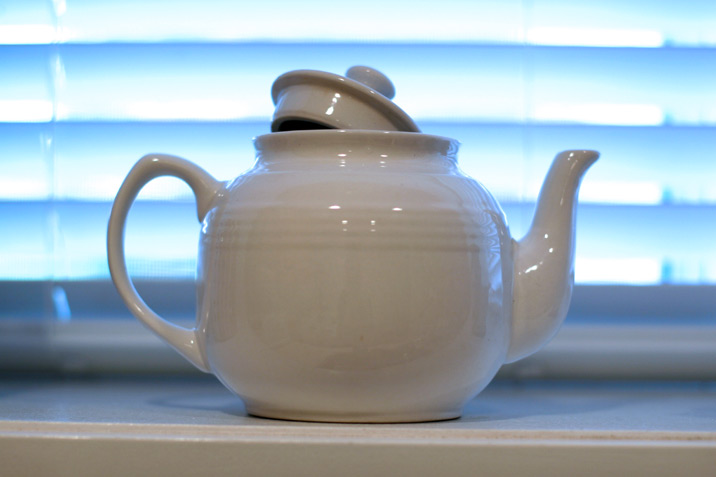
Tea has always been a part of my life, and I’ve gotten pretty particular about how I like it. I like all kinds of black tea and happen to know a bit of trivia about other kinds of tea as well, such as caffeine content, origin of leaves etc. I particularly like Earl Grey Tea and so this is a short post on how I like to make it.
I find the bagged teas to be generally bland, milder, more washed out flavours and really just not quite the same experience as loose leaf tea. They’re still tea, but it always feels like a compromise for the convenience of bagged tea, which at home I do not need. When I am out, I am certainly not as fussy about how it’s prepared.
What do I use to make tea then?
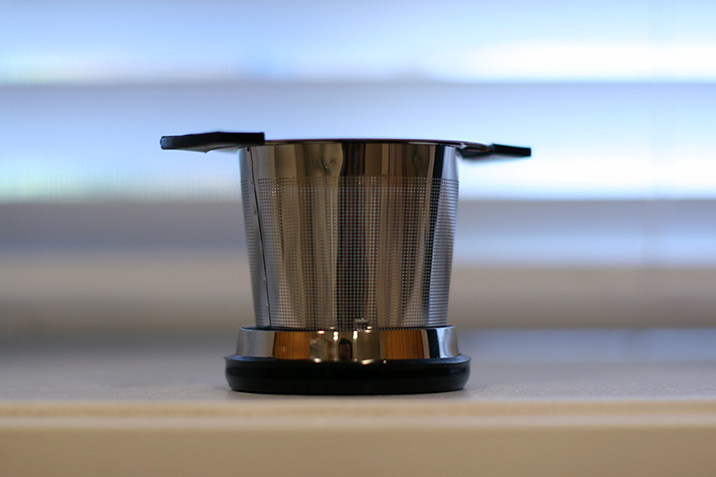
For loose leaf tea I use a brewing basket. We recently picked this one up from Victorian Epicure, but you can get them almost anywhere. Basically this thing sits on top of your mug or tea pot and you throw the tea leaves in it. The handles do a great job of not letting the basket fall in past the rim. When you’re done, it takes 10 seconds to turn this thing over and wash it out.
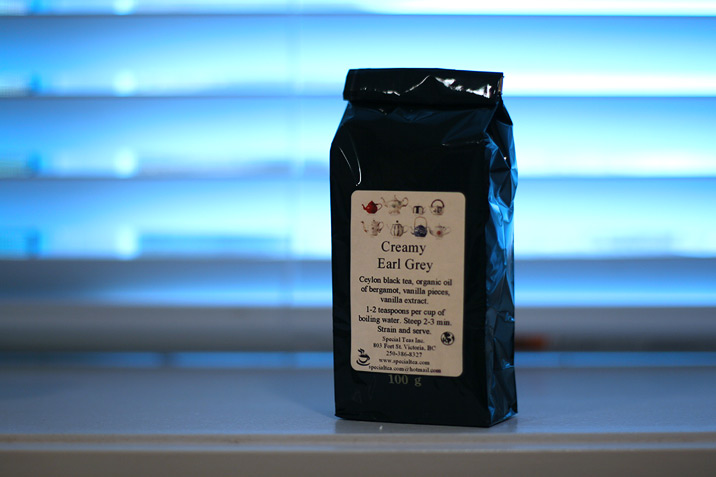
This has to be my favorite earl grey tea from any shop, anywhere. As you can see, it is from the cleverly named SpecialTeas on Fort & Blanshard, in downtown Victoria. The “creamy” really means that there is some vanilla in the mix, smoothing the taste and adding some complexity to balance the bergamot oil which makes earl grey not just another black tea. As the bag suggests, brewing around 3 minutes at the right proportions leaves you with a brilliant tasting creamy earl grey tea that I find more satisfying every day. Overbrew a couple minutes for some more flavour, but be aware that you’ll also be getting more caffeine.

I usually have milk in the tea, but sometimes – like this morning – I will drink it without. I don’t always have sugar in my tea, but every now and then I do like it. I have been listening to my friends talk about the superiority of raw, unprocessed cane sugar lately, and I found these raw cane sugar cubes at the local corner store. Per gram, they happen to be cheaper than the bags of raw sugar – which is weird, considering they need more attention to finish the product.
Anyway, that is how I like my tea. How do you like your tea?
more sizes

February steamrolls ahead into 2009 and we’re well into the winter semester now. I wrote a paper on project management execution and control last week – if anyone’s interested in reading it I will post it. Maybe I’ll post it anyway just for reference, along with the risk management and initiating and planning papers.
The goal of this site is to be a scalable resource-based site for anything that I want to put my name to. This includes my photography, mixes, production, writing, and design. I haven’t put a lot of design work up but it’s here, incidentally, through all the mix covers, production art, and site design. My writing is what you see here – but it’s not the only writing I do.
Some might suggest that I maintain a different website for each one of those disciplines, but to me there are at least three problems with that. Problem one is that they’re not all mutually exclusive disciplines, and they have a way of bleeding a lot into each other under the surface. Problem two is that maintaining four or five websites is a lot of work and spreads the updates thinly due to constraints of time and convenience. Problem three is that I am one person, and I’d like to appear as such. That might sound funny, but splitting off into many different areas, also under alias as I have in the past, undermines the ability to connect things that might not otherwise seem to be that close together. I used to do graphic design under a company name, DJ under another name, produce under several different names, and only write under my name. The separation, though a seemingly cool group of ideas, never focussed on who I actually was – just segments of who I wanted to be.
Sometime soon I want to put my design portfolio up. I haven’t updated my portfolio in a really long time but I’ve been a part of many design projects over the last several years and it would be nice to display some of that here.
All that said, it is Monday morning and I’d like to cut this off here before I create too much work for myself! Time for some more breakfast.
Trifecta – Terraforce
To say the first Trifecta release is a long time in the making is a severe understatement. This started off as a communal track a few years ago between myself, Dustin H and Justin (Formulate/Humbertron). We each took turns working on the basic sounds, melody and drum sounds and passed the working files back and forth around 6 or 9 times. Then once we had a chunk of it done and a couple movements, we all took it in our own directions resulting in the three finished mixes of the track:
- Trifecta – Terraforce (AFK mix)
- Trifecta – Terraforce (Dustin H mix)
- Trifecta – Terraforce (Humbertron mix)
We came up with the group name after going through several different potential names. We wanted something that would represent the three of us and Trifecta seemed to fit. At the time there were no other “Trifecta”s on Beatport, but as of this post there appears to be a “Tri-Fecta” which Beatport erroneously attributed the track to. That’s not us, and a change request has been filed so hopefully they fix that soon without breaking the link to the release.
“Terraforce” is just a made up word which means earth (terra) power (force). Lets greenwash this by saying that Terraforce will be released digitally only, eliminating tonnes of physical waste that is the result of making CDs and records and shipping them! More power to the earth.
The cover art is made of a few images – one is a volcano (I did not take it myself, but I did pay to license it for this) and then some other miscellaneous textures that have been given a spotty mosaic blend as well as some other stuff.
february trancewalk
When the weather gets nicer, and the days last longer, it makes you want to spend a little more time outside, walking around and listening to some music. I have around 43 tracks for consideration for Pacific Front Sessions: March 2009, so I am listening and mentally shortlisting to the final 8 or 9 already. Also I’ve been practicing getting the shot I want right the first time as it’s becoming more important with Bergamot‘s endeavors. I am posting 11 photos out of 21 photos that I took total in the last two days – that’s just over 50% success, which is very good in my books. Of course, inanimate subjects make much more consistent subjects than animate ones. Still, focus, looking for the right angle for the available light, composition and framing are good things to practice and this was very satisfying.
More photos after the break.
new meaning
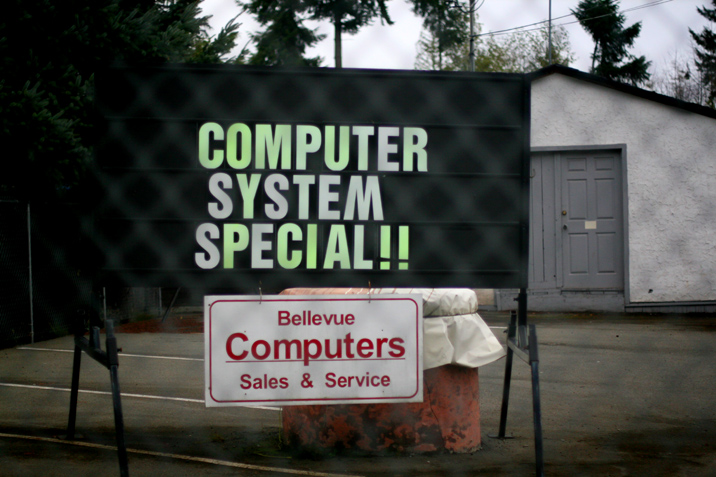
New meaning is far too broad of a topic to write about so instead I will leave you with this photo. Perhaps it means something different to you than it does to me?
I took this photo from the street (you can see the chainlink fence this was shot through, blurred out) on the way back from Tofino. I don’t exactly know where we were as we took a secret shortcut which lead us to Englishman River Falls, but it’s not in Bellevue, Washington.
mists of the night
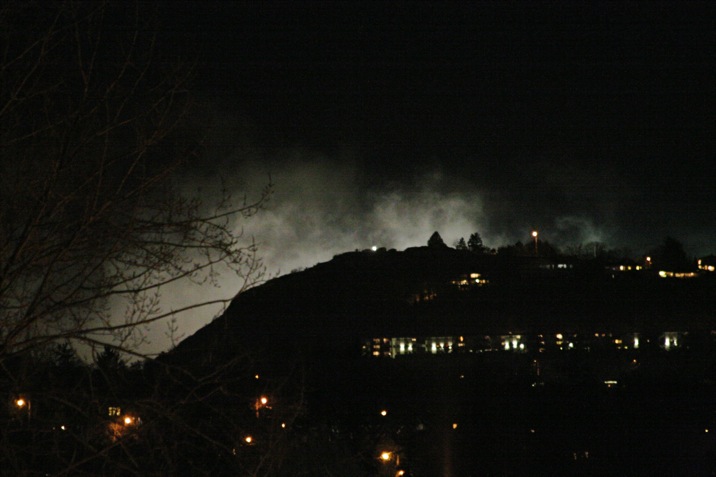
This is a well known landmark in Victoria, Mt. Tolmie, backlit with some mists over the University of Victoria in the background. Taken from my deck downtown, this is facing north-east.
300MM (480MM film equivalent), aperture: F5.6, shutter: 1/8, ISO3200. I think I shot this hand-held, but I can’t remember for sure. I have pretty steady hands, and Image Stabilization would have helped.
Say, I wonder how closely digital photography ISO increases came to conflicting with completely non-photography related international standards. Good old ISO12232:2006 would probably shed some light on that subject for those willing to pay 92 Swiss francs. I’ll leave that gem for a photography instructor.
For those not familiar with what camera ISO means, it’s a measure of sensitivity for the image sensor inside your camera. On film cameras, that would mean how fast the film inside will react (expose) to being hit by light, and on digital cameras, that means how much light is required to make an impression on the image sensor inside. The higher the ISO number, the more sensitive your film or image sensor is. Long story short, the darker it is, the higher ISO you’ll need.
Sounds simple enough. In practice, when you pump up the ISO from 50-100 (usually used in daylight) to 400-800, what you’re doing is telling the image sensor to collect more data than usual. This means that, in addition to getting your relatively faint subject, your camera will also be collecting useless data, which is referred to as (film) grain or visual noise. This is the trade-off of increased sensitivity – you get a bit more of everything, even stuff you don’t want.
Personally I don’t mind some grain in a photo – it shows a bit of the determination required to get the photo in the given environment. Some of the advances in the newer digital SLRs are in regard to image sensor ISO capabilities, with the new Canons and Nikons going up to ISO25600 and beyond. I would imagine this level of ISO to be extremely grainy or noisy, and henceforth require some serious noise reduction. DPReview has a simple visual to help illustrate what is meant by noise.
This is pretty cool technology as it allows you to take photos in relatively low light. Before companies were competing on camera ISO – when ISO capabilities found themselves in stasis – you would have to lower your aperture to take low-light photos. It might not sound like a big deal, but when you depend on lens construction for lower light capabilities, you are bound by focal length and the sheer expense of low aperture glass. With aperture, the lower you go (measured in “F” stops), the more light can get into the camera and hit the sensor or film. For Canon, a 50MM F1.8 lens could cost around $70-$200; a 50MM F1.4 lens will likely cost between $300-$600; a 50MM F1.2 lens will cost even more, around $1500. As you can see, going down by small amounts of aperture costs a lot and is restricted to the lens that is on the front of your camera. Since ISO settings are a part of the camera and not the lens, those with dSLRs may switch lenses and retain the benefit of higher ISO capabilities.
In conclusion, ISO is important if you feel like shooting at night without a tripod. If you feel like lugging a tripod around with you at all times, then this will be less relevant to you. Of all the technologies that are being pushed on higher end consumer dSLRs, this is one the items that excites me the most as it makes less expensive equipment more effective and valuable.
Ok, back to sleep. Yes, I really did wake up at 4:30 AM and write for an hour straight on ISO.
bergamot studios launch
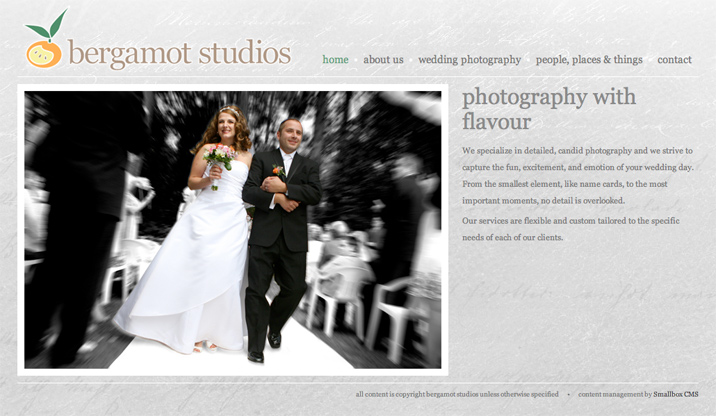
It’s been over a year since we settled on a name for our photography business. Since then we have done a lot of shooting, setting up the business on the administrative side, collaborated on a logo and also made a website design. The website itself is powered by the content management system I work on in the day time.
Our focus is wedding and event photography. We also shoot bands, DJs, and do headshots and the like. We have had thoughts about opening up the design side as well, but for now it makes the most sense to have the business focus on photography. May I present to you:
Bergamot Studios: Photography With Flavour
Comments, grammar advice, enquiries and Earl Grey tea all welcome!